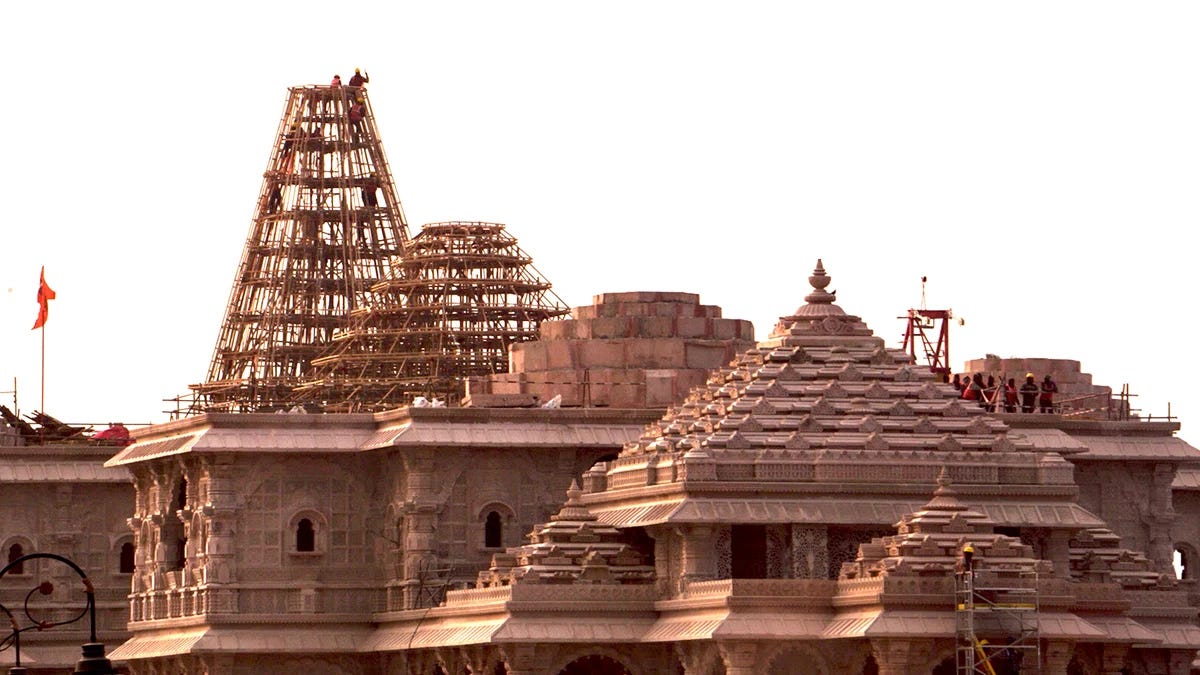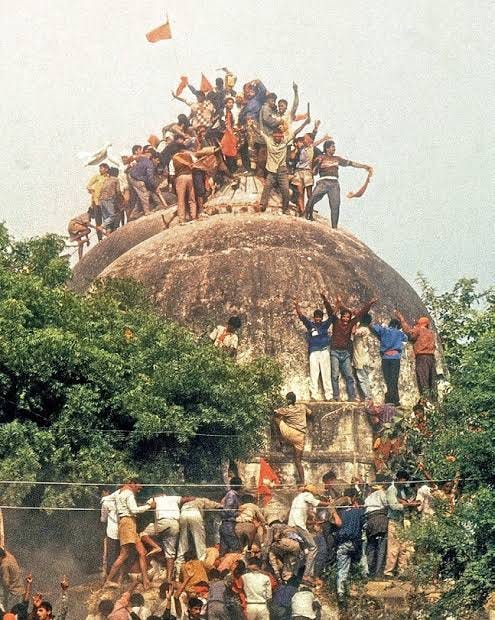Here’s How To Maximize The Benefits Of Ayodhya Ram Temple Akshata
Or How Hindusim Came Into Being; Brief History Of Hindu Religion For Zoomers-n-Boomers Who Refuse To Pick Books

I was just on a call with my distant neighbour who after the regular round of questions asked me if I had received the Ram-Mandir-Rice (akshata). For those who haven’t and don’t know about what’s going on, people associated with BJP-RSS have been going door-to-door and distributing some posters related to the new temple in Ayodhya, Uttar Pradesh along with some colourful uncooked-unbroken-rice in tiny plastic pack (hardly 20 gram).
Akshata basically consists of uncooked un-broken pieces of rice which is mixed with turmeric. It is sometimes used to bless bride and groom during weddings. Akshata is also sprinkled during other auspicious ceremonies. When Akshata is offered to a deity, it is believed to be the finest offering that a devotee can make. Akshata is believed to be equal to offering clothes, jewelry, food, or any other offering. Akshata is usually thrown over the head of the devotees during pujas and during functions like marriage and other auspicious events.
The akshata attract the subtle frequencies of five principal deity namely Shiv, Shakti, Shri Ram, Shri Krishna and Shri Ganesh. Akshata is the central point of puja plate. If the rice grains used for preparing Akshatas are broken then their capacity to attract the principles of higher deities is automatically reduced. When the akshtas are offered to a deity the energy of the deity is transferred in it and favourable vibrations are generated in akshatas.
— Hinduism StackExchange
There is a lot that’s wrong in the above description but since all this is a matter of faith, let’s go ahead with it. Or just ask any Hindu person around you what ‘Akshata’ is. If the above description is right then how come RSS-BJP members have akshata even before the inauguration of the temple?
Returning back to my phone call.
I answered in the affirmative. I was then told to add some more grains to this 20-gram ‘akshata’ and prepare some sweet dish out of this mixture and have it. I was also told to take two to three grains from the 20-gram packet and wrap them in a piece of paper after writing ‘Shri Ram’ thrice over it and to keep this paper in my cupboard/locker.
Where is all this coming from? Who tells them? And even if someone does, how come people believe in this nonsense?
I have seen so many religious celebrations in my life. Never once am I aware of ‘akshata’ being used as this. In fact, unlike what that description claims, ‘akshata’ from the floor is just swept away like any other dirt. Few do collect it separately. At my place, since we have a river in the vicinity, they throw this rice in the water the next morning. I don’t know what people in cities do.
Let’s talk about this new temple now, shall we?
The temple will be inaugurated on Jan 22, 2024. The temple is not complete yet. By most estimates it would take at least two more years for its completion. Why so much hurry then? There’s a general election this year. By all predictions, RSS-BJP is going to sweep that election. Temple inauguration and these foot soldiers going door-to-door is merely to ensure it.
There have been many instances of people close to RSS-BJP profiting from temple construction. For one such example, read this:
It’s a prime property of 890 sq meters, a piece of land where the grand Ram temple complex will soon come up. Until February this year, it belonged to a mahant, Devendra Prasadacharya. On February 20, one Deep Narayan bought the land — gata number 135 — from the mahant for Rs 20 lakh.
Narayan is the nephew of Rishikesh Upadhyaya, the Bharatiya Janata Party leader who is the mayor of Ayodhya. Land records accessed by Newslaundry show that three months later, on May 11, Narayan sold the property to the Ram Janmabhoomi Trust, set up by the Narendra Modi government to oversee the temple’s construction, for Rs 2.5 crore.
— Ayodhya: Whose Land Is It Anyway?
Forget questioning people in power over this loot, none in big media even bothered to report on this. I would be surprised if you wondered why.
I would not mention people, mostly poor, whose houses were demolished to make space for a grand home to lord Ram. By now I have completely understood how there is no value to a poor man’s life and livelihood. For instance, the government of Madhya Pradesh demolished the house of a Muslim person for spitting on a Hindu religious procession. He was jailed too. But in court it was found that no such incident had taken place. Police had made two people (police’s “witnesses” ) sign on blank papers. They denied seeing any such spitting incident in court. But did any of us ask what of that poor man’s demolished house now? No. Again, the media didn’t see it worth covering. It would puncture the popular narrative now, won’t it?

The domed structure was a 464-year-old mosque believed to have been constructed by or at the instruction of the Mughal emperor Babur. Babri Masjid, the lone structure of significance to Muslims in the area, stood surrounded by holy buildings built by Hindus later — Manas Bhawan, Sita Rasoi and Ram Katha Kunj Sagar. The mosque had existed for centuries and Muslims offered namaz there. Soon after independence, in December 1949, Hindus discreetly installed an idol of the deity Ram Lalla under the central dome, persisting with their claim that the plot on which Babri Masjid stood was the birthplace of the Hindu god Rama.
The conundrum had begun. Who should get the land title, Hindus or Muslims? The case travelled for years through the judicial labyrinth until finally, on November 9 this year, the Supreme Court gave away the title to Hindus.
It took the five judges who decided the case to travel back in time to 300 BC to explain why the land “probably” belonged to Hindus. The court categorically said towards the beginning of its 1,045-page judgement: “The court does not decide title on the basis of faith or belief but on the basis of evidence…The law must stand apart from political contestations over history, ideology and religion.’’ Yet, it ended up doing just that. It went on to rule that Hindus had a stronger claim to the title because of their belief.
— Ayodhya verdict: A conundrum of fact, fiction and faith
The idol of Ram was placed inside the mosque in 1949 — which VHP and Sangh claimed had miraculously appeared that night; but it is not this idol that the new temple will have. The Temple trust had arranged a fashion show of probable idols and chose one from the lot (Voting on Lord Ram Lalla’s idol today, temple trust to select best among three designs). Turns out, the new temple trust does not believe in miracles. Some scientific temperament there. Good for them.
Away from all this noise, I keep wondering, what if there was no mosque in Ayodhya, how would they then choose Ram’s place of birth? Before the British started spreading the rumour of the mosque being that place, so many temples to Ram in Ayodhya claimed that theirs was the spot at which their lord was born. In this context, it is a good time to rewind and remember how Hinduism as a religion was born under British rule as a reaction to Islam. What we today refer to as Hinduism was historically called or known as Brahmanvaad/Brahmanism/vedic-brahmanism etc. No one identified as Hindu before the British started holding provincial elections or census. How do you for instance digest the fact that the Vedas, the books that Hindus use to bolster their claim to state how old their religion is, does not mention Ram or for that matter any god that is worshiped today?
While temples are highly regarded today in Hinduism, our own old religious books disrespect them and write of them in poor light. Vishnu Smriti for instance “says that Vedic recitation should not be carried out ‘in a temple, in a cemetery, at a crossroads, or on a road.’ Placing a temple next to a cemetery is telling. Ritual specialists associated with temples were called devalaka. They were despised by the authors of Dharmashastras. The devalaka is listed among those who should not be invited to an ancestral offering (shraddha), Manu listing them between physicians and butchers.”
From my own limited reading, I have understood this much: Before Aryans migrated to what we today refer to as India, there were already people here. Harappans for one example. And they had their own beliefs and gods (don’t know how they viewed them and what they called them). For instance, Nataraja (who we today view as a form of Shiva) is imported from Harappans. Vedas were written by Aryans. These were the books that informed us about Brahman and their importance. Basically, those who wrote these books were Brahmans and they were superior in all kinds, had all rights and could not receive any punishment as per these books. They were, as per these books, mediators between god and people. Which god? The ones mentioned in the books they had written. They tried to enrol indigenous people into their religion but could not find great success. Another point to note here is how all these Vedic rituals involved large-scale offerings to gods which were impossible for common folk to undertake. All rituals required Brahman's help in invoking gods. These gods could not be prayed to on your own like we are familiar today. Side note: Vedas and early books mention meat eating including beef. In fact, brahmans themselves were extreme beef eaters. I’m not saying it, Ambedkar did. He wrote a detailed paper on this bit of history using Vedas and other scriptures. So in essence, it is not even Ambedkar saying Hindus were beef-eaters but Hindu books themselves. But then the question arises, why did we abandon beef-eating? The answer in all likelihood lies in Buddhism. There was a time when Buddhism and Jainism spread far and wide in India. People started enrolling in hordes. Many kingdoms in the north adopted Buddhism and in the south, they embraced Jainism. This left Brahmans staring at an existential crisis. Their whole thesis relied on them being superior to others in the caste pyramid but what would happen when no one remained under the bottom part of the pyramid? And so began the writing of Puranas and the invention of the very many gods. While some were invented from thin air, many were local gods prayed to by non-aryan locals who were given Vedic makeovers. And so gradually vedic gods whom local people refused to adopt were abandoned in favor of Puranic gods. It is these gods that we continue to pray today. People hated large rituals and yagnyaas where mass slaughter of animals used to take place and in reaction were flocking to Buddhism. To counter this, it seems Brahmans themselves abandoned eating beef. And went a step further by creating stories of bovine’s divinity. What was once the food of Brahman was now converted into a divine entity. It was a method employed to survive. And temples which were once decried bad were now embraced wholeheartedly because by now Buddhists had started to build large structures of their own.
This is the only explanation that answers why Hindus have so many gods, how two people who pray to two separate gods and who on varied occasions are even unaware of each other's gods could still claim to be part of a single religious entity.
This is also why caste is always defended in myriad ways since it is at the heart of the Hindu religion’s existence. Only for the sake of caste was this religion created or put more sordidly, to protect the superior position of Brahmans or upper caste over everyone else.
The shankaracharyas head the four Hindu mathas (monasteries) — in Dwarka (Gujarat), Joshimath (Uttarakhand), Puri (Odisha), and Sringeri (Karnataka) — that are believed to have been founded by the eighth-century religious scholar and philosopher Adi Shankara.
(Adi Shankara is one of the most important figures in Hinduism)
“The temple belongs to the Ramanand sect, and not to the Sanyasis, not to Shaiva or Shakta.” — Champat Rai, general secretary of Shri Ram Janmabhoomi Teerth Kshetra Trust
So does Ram belong to Hinduism? Does Shankaracharyas belong to Hinduism? Is the answer to both of these questions the same? Then, what is Champat Rai saying above? Why is he hinting that this new temple does not belong to all Hindus? If he is out-of-line (that seems to be the only argument which could keep both Ram and Shankaracharya in Hinduism) then why have Hindus not been outraged, why have they not asked for Champat Rai’s removal? It’s not like Hindus are a tolerant lot — that’s not the image Modi-years have presented. Didn’t the same lot that took down Babri Masjid murder the original pujari of Ramjanmbhoomi Temple who destroyed VHP, RSS, and Advani’s arguments and condemned the Rath Yatra which killed thousands?
Let me repeat myself. It has now become impossible to project Hindus as peaceful lot. Or Hinduism as the religion of peace, harmony or love. Modi years have ensured that much. Modi years have done to Hinduism what ISIS/Taliban did to Islam. Mind you, Muslims could wash off taints of Taliban/ISIS from them but how will Hindus wash off RSS and Modi who are defended and bolstered by ordinary masses day in and day out. Unlike Taliban, RSS-BJP-Modi are not fringes. They are as mainstream as anything could be. Voted twice. The first vote was despite Gujarat 2002 and Babri Masjid demolition or because of these very facts. And so this is our reality now. We have to live with it. There is no running away from this taint anymore.
If you have reached here, do consider reading the below piece.


Comments
Post a Comment